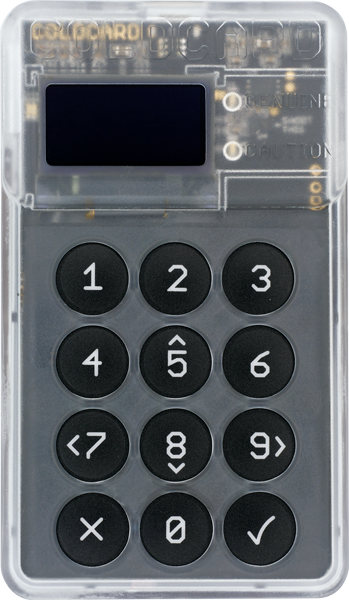Coinkite Coldcard Description 2024
The world needs an open, cheap and secure hardware wallet
What is the Coinkite Coldcard? It is a Bitcoin hardware wallet that can be used offline and signed for transactions.
- BIP39 based, meaning you can back up the secret words on paper and have many sub-accounts and unlimited independent payment addresses. Now with BIP39 passphrase support that unlocks countless extra wallets from the same seed words!
- It knows how to understand transactions so you can see what you’re approving.
- The first “ParSigned Bitcoin Transaction Format”-PSBT (GDP 174) native wallet, which can be used completely offline throughout the lifecycle.
New in version 2 of the Coinkite Goldcard
- Physical buttons! Click click click click
- Better energy management & ESD protection
- Tempest anti-monitoring features for keypad scanning and power savings by removing touchkeys
- More physical protection on sensitive tracks, which improves the safety between the safe element and the main microscope.
- Boat security improvements: Includes updates to prevent und/or detect MiTM attacks.
- “SHOOT THIS” markers for effective device destruction
- Activity LED for MicroSD card slot
- Only software improvements work on older devices.
The Coinkite Goldcard is different
NO special software required. It accepts standard PSBT transactions (GDP 174) stored on a MicroSD card. NO companion application on your computer necessary, already works with the main wallets (Electrum and more in preparation).
It’s cheap! Simple packaging, simple design, no fancy boxes, no redundant cables.
It’s ultra easy! Real crypto security chip. Your private key is stored in a special security chip, not in the flash of the main microkro.
Easy backup! MicroSD card slot for backup and data storage. This allows for real offline signing by transferring the unsigned transactions via the sneaker net.
Open source software design runs on micropython and you can change it.
Other features
- The full-fledged numerical keyboard allows easy and quick input of the PIN.
- Larger 128×64 OLED screen.
- Sign text messages to prove control of the private key.
- Join other signatories in multisig wallets.
- Encrypn/decrypt secret messages (stored on MicroSD or otherwise).
Product Specifications
| Compatibility | Electrum |
| Cryptocurrencies | Bitcoin |
| Brand | Coinkite |
| Platform | Windows, Linux, Mac |
| Altcoin Support | |
| Supported Coins | 1 (to the complete list) |
| Open Source | |
| Secure Element | |
| Display as 2FA | |
| Interfaces | USB, microSD |
User Reviews 0
No reviews yet


FAQ 0
Ask your own questionNo questions about the product available yet